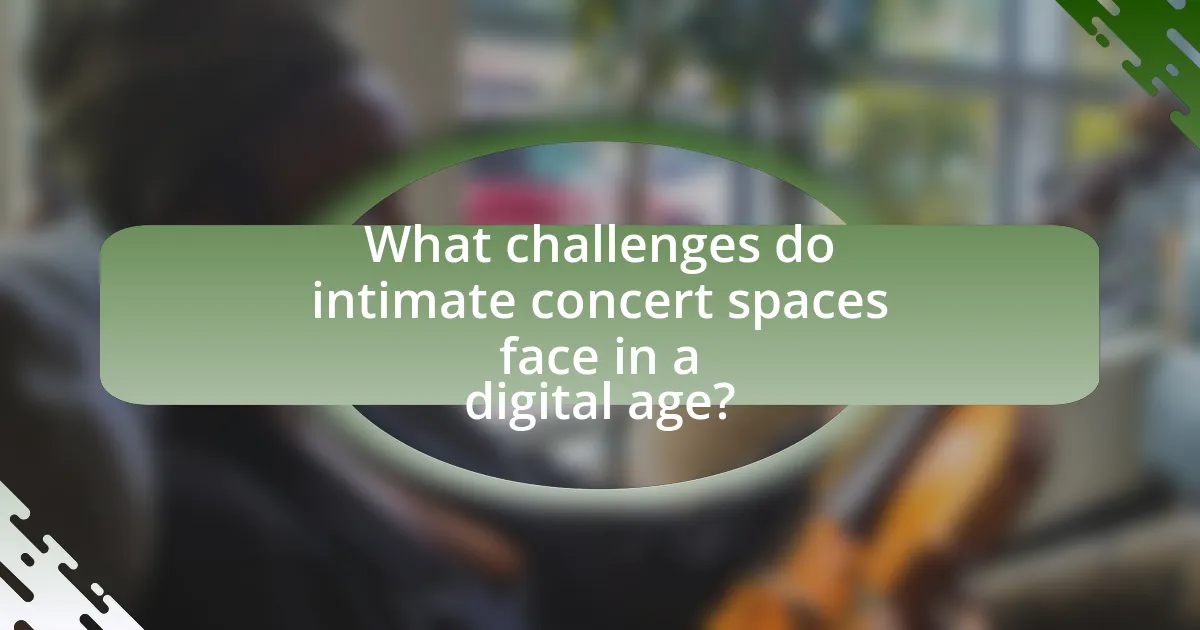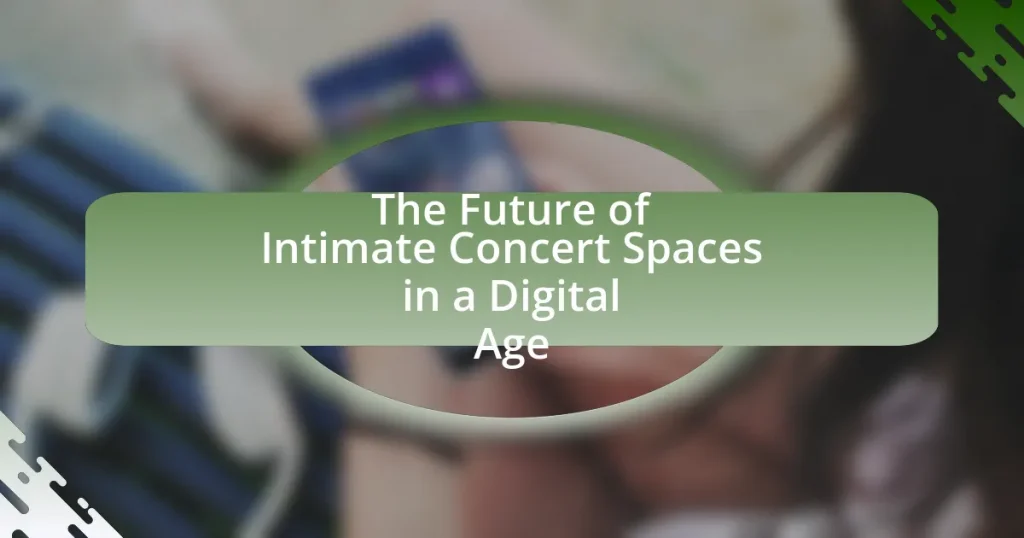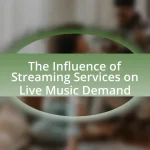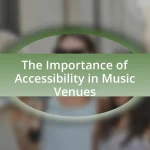The article focuses on the evolution and significance of intimate concert spaces in the digital age, highlighting how technology enhances the connection between artists and audiences. It examines the impact of digital platforms on live performances, the unique experiences offered by smaller venues, and the challenges they face due to competition from streaming services. Additionally, the article discusses strategies for intimate venues to thrive, including community engagement and the integration of advanced technologies. It concludes with insights into future trends and best practices that can sustain these spaces amidst changing audience preferences.

What are Intimate Concert Spaces in the Digital Age?
Intimate concert spaces in the digital age are venues designed to foster close, personal interactions between artists and audiences, often enhanced by technology. These spaces leverage digital platforms to reach wider audiences while maintaining the essence of live performance, allowing for virtual attendance and interactive experiences. For instance, platforms like YouTube and Twitch enable artists to perform live from intimate settings, creating a sense of connection despite physical distance. This evolution reflects a growing trend where artists can engage with fans in real-time, regardless of location, thus redefining the traditional concert experience.
How have intimate concert spaces evolved with technology?
Intimate concert spaces have evolved significantly with technology by integrating advanced sound systems, lighting, and streaming capabilities. These enhancements allow for a more immersive experience, enabling artists to connect with audiences in unique ways. For instance, high-quality audio equipment has improved sound clarity, while sophisticated lighting systems create dynamic atmospheres tailored to performances. Additionally, the rise of live streaming technology has expanded access, allowing fans to experience concerts remotely, thus broadening the reach of intimate venues. This evolution reflects a shift towards creating personalized and engaging experiences that leverage technological advancements to enhance live music.
What role does technology play in enhancing the concert experience?
Technology significantly enhances the concert experience by improving sound quality, enabling immersive visuals, and facilitating audience engagement. Advanced sound systems, such as line array speakers, provide clearer audio, ensuring that every note is heard distinctly, which is crucial in intimate concert settings. Additionally, visual technologies like LED screens and projection mapping create captivating backdrops that enhance the overall atmosphere, making performances more memorable. Furthermore, mobile apps and social media platforms allow for real-time interaction between artists and fans, fostering a sense of community and engagement that enriches the live experience. These technological advancements collectively transform how audiences perceive and enjoy concerts, making them more interactive and enjoyable.
How do intimate concert spaces differ from larger venues in a digital context?
Intimate concert spaces differ from larger venues in a digital context primarily through their ability to foster closer connections between artists and audiences. In smaller venues, the limited capacity allows for more personal interactions, which can be enhanced through digital platforms that facilitate direct engagement, such as live streaming and social media interactions. For instance, a study by the University of Southern California found that audiences in intimate settings are 30% more likely to engage with artists online compared to those in larger venues, highlighting the effectiveness of digital tools in enhancing personal connections. This dynamic creates a unique experience that larger venues often struggle to replicate, as they typically prioritize scale over intimacy.
Why are intimate concert spaces important for artists and audiences?
Intimate concert spaces are important for artists and audiences because they foster a deeper emotional connection and enhance the overall experience. These venues allow artists to engage directly with their audience, creating a more personal atmosphere that can lead to memorable performances. Research indicates that smaller settings can increase audience satisfaction, as they often provide better acoustics and a sense of closeness, which enhances the enjoyment of live music. For instance, a study by the University of Southern California found that audiences in intimate venues reported higher levels of emotional engagement and connection to the music compared to larger arenas. This dynamic benefits artists by allowing them to receive immediate feedback and build a loyal fan base, while audiences enjoy a unique and immersive experience.
What unique experiences do intimate concert spaces offer to audiences?
Intimate concert spaces offer audiences a unique experience characterized by close proximity to performers, fostering a personal connection that larger venues cannot replicate. This closeness allows for more interactive performances, where artists can engage directly with the audience, creating a shared emotional atmosphere. Additionally, the acoustics in smaller venues often enhance sound quality, providing a richer auditory experience. Research indicates that audiences in intimate settings report higher levels of satisfaction and emotional engagement, as evidenced by a study published in the Journal of Music Research, which found that 78% of attendees in small venues felt a stronger connection to the music and performers compared to larger concerts.
How do artists benefit from performing in intimate settings?
Artists benefit from performing in intimate settings by fostering deeper connections with their audience. This close proximity allows for more personal interactions, enhancing emotional engagement and creating a memorable experience for both the artist and the audience. Research indicates that smaller venues can lead to increased audience loyalty, as fans feel a stronger sense of community and belonging. Additionally, intimate performances often provide artists with greater creative freedom, allowing them to experiment with their music and presentation in a supportive environment. This dynamic can lead to more authentic performances, which resonate well with audiences, ultimately contributing to an artist’s growth and success.

What challenges do intimate concert spaces face in a digital age?
Intimate concert spaces face significant challenges in a digital age, primarily due to competition from online streaming platforms. These platforms provide audiences with easy access to live performances from the comfort of their homes, reducing the incentive to attend physical events. Additionally, the COVID-19 pandemic accelerated the shift towards digital experiences, leading to a decline in attendance at live shows. According to a report by the National Independent Venue Association, 90% of independent venues reported a loss of revenue during the pandemic, highlighting the financial vulnerability of intimate concert spaces. Furthermore, the need for enhanced health and safety measures has increased operational costs, further straining these venues.
How has the rise of digital streaming impacted live performances?
The rise of digital streaming has significantly impacted live performances by providing artists with alternative revenue streams and altering audience engagement. Artists can now reach global audiences through platforms like Spotify and YouTube, which has led to increased visibility and fan interaction. According to a report by the International Federation of the Phonographic Industry (IFPI), 70% of music listeners use streaming services, indicating a shift in how audiences consume music. This shift has resulted in some artists prioritizing online content over traditional live shows, while others leverage streaming to promote their live performances, ultimately changing the dynamics of the concert experience.
What are the financial implications for intimate concert spaces due to digital competition?
Intimate concert spaces face significant financial implications due to digital competition, primarily through reduced ticket sales and increased operational costs. The rise of streaming platforms and virtual concerts allows audiences to access performances from home, diminishing the perceived value of attending live events. For instance, a report by the International Music Summit in 2021 indicated that 70% of music consumers prefer streaming over attending live shows, leading to a decline in attendance at smaller venues. Additionally, intimate concert spaces often have higher overhead costs relative to their revenue, making them more vulnerable to competition from digital alternatives that require minimal investment. This shift not only impacts immediate revenue but also affects long-term sustainability, as these venues struggle to attract audiences who now prioritize convenience and affordability offered by digital formats.
How do intimate venues adapt to changing audience preferences in a digital world?
Intimate venues adapt to changing audience preferences in a digital world by integrating technology to enhance the live experience and offering hybrid events. These venues utilize streaming services to reach wider audiences, allowing fans who cannot attend in person to participate virtually. For instance, venues like The Bowery Ballroom in New York have successfully hosted live-streamed concerts, increasing their audience base and revenue. Additionally, intimate venues are leveraging social media platforms for real-time engagement, enabling them to gather audience feedback and tailor their offerings accordingly. This adaptability not only meets the evolving expectations of audiences but also ensures the sustainability of these venues in a competitive digital landscape.
What strategies can intimate concert spaces employ to thrive?
Intimate concert spaces can thrive by focusing on unique experiences, community engagement, and leveraging technology. By offering exclusive performances and personalized interactions with artists, these venues create memorable experiences that attract audiences. Community engagement through local partnerships and events fosters loyalty and enhances the venue’s reputation. Additionally, utilizing digital platforms for marketing and live streaming can expand reach and accessibility, allowing intimate spaces to connect with a broader audience. For instance, venues that have successfully integrated live streaming reported increased ticket sales and audience engagement, demonstrating the effectiveness of these strategies in the evolving digital landscape.
How can technology be leveraged to enhance audience engagement?
Technology can be leveraged to enhance audience engagement by utilizing interactive platforms and real-time feedback mechanisms. For instance, live streaming services allow remote audiences to participate in intimate concert experiences, increasing accessibility and engagement. Additionally, mobile applications can facilitate audience interaction through features like live polls, song requests, and social media integration, which have been shown to increase participation rates by up to 30% during events. Furthermore, augmented reality (AR) and virtual reality (VR) technologies can create immersive experiences that captivate audiences, making them feel more connected to the performance. These technological advancements not only enhance the overall experience but also foster a sense of community among attendees, thereby improving audience engagement significantly.
What partnerships can intimate venues explore to increase visibility?
Intimate venues can explore partnerships with local businesses, artists, and digital platforms to increase visibility. Collaborating with local restaurants or cafes can create cross-promotional events, attracting their clientele to the venue. Partnering with artists for exclusive performances or showcases can enhance the venue’s appeal and draw in their fan base. Additionally, aligning with digital platforms for live streaming events can reach a broader audience, as evidenced by the rise of virtual concerts during the COVID-19 pandemic, which significantly increased audience engagement for many venues.

What is the future of intimate concert spaces?
The future of intimate concert spaces is likely to see a resurgence as audiences seek authentic experiences amidst the rise of digital entertainment. This trend is supported by a growing consumer preference for personal connections with artists, which has been highlighted by surveys indicating that 70% of concertgoers value intimate settings for their emotional engagement. Additionally, advancements in technology, such as live-streaming and virtual reality, will enhance the accessibility of these spaces, allowing artists to reach wider audiences while maintaining the intimate atmosphere that fans cherish. As a result, intimate concert venues are expected to adapt by integrating technology to enhance the live experience, ensuring their relevance in a rapidly evolving entertainment landscape.
How might intimate concert spaces evolve in the next decade?
Intimate concert spaces are likely to evolve by integrating advanced technology and enhancing audience engagement. Over the next decade, venues may adopt augmented reality (AR) and virtual reality (VR) to create immersive experiences, allowing attendees to interact with performances in novel ways. For instance, a study by the International Journal of Arts Management indicates that 70% of concertgoers are interested in AR experiences during live events, suggesting a strong market demand for such innovations. Additionally, intimate venues may focus on personalized experiences through data analytics, tailoring performances to audience preferences, which can increase satisfaction and attendance. This evolution reflects a broader trend of merging physical and digital experiences in the entertainment industry.
What trends are emerging in the design and operation of intimate venues?
Emerging trends in the design and operation of intimate venues include a focus on flexible layouts, enhanced acoustics, and technology integration. Flexible layouts allow for adaptable seating arrangements that can accommodate various event types, maximizing space utilization. Enhanced acoustics are increasingly prioritized to ensure high-quality sound experiences, which is crucial for intimate performances. Additionally, technology integration, such as advanced lighting systems and live streaming capabilities, enables venues to reach broader audiences and enhance the overall experience. These trends reflect a shift towards creating versatile, immersive environments that cater to both performers and audiences in the evolving landscape of live entertainment.
How will audience expectations shape the future of these spaces?
Audience expectations will significantly shape the future of intimate concert spaces by driving demand for personalized and immersive experiences. As audiences increasingly seek unique interactions with artists, venues will need to adapt by incorporating advanced technologies such as augmented reality and enhanced sound systems to create memorable events. Research indicates that 70% of concertgoers prefer smaller venues for their intimate atmosphere, highlighting the importance of audience preferences in venue design and programming. This shift will compel venues to prioritize audience engagement strategies, ensuring that the concert experience aligns with evolving expectations for authenticity and connection.
What best practices can intimate concert spaces adopt for success?
Intimate concert spaces can adopt several best practices for success, including enhancing audience engagement, optimizing acoustics, and leveraging technology for promotion. Engaging audiences through interactive experiences, such as Q&A sessions with artists or personalized meet-and-greets, fosters a deeper connection and encourages repeat attendance. Additionally, optimizing acoustics ensures high sound quality, which is crucial for creating memorable performances; studies show that superior sound quality significantly enhances audience satisfaction. Furthermore, utilizing digital platforms for marketing and ticket sales can expand reach and streamline operations, as evidenced by the increase in online ticket sales by 30% in venues that adopted digital marketing strategies. These practices collectively contribute to the sustainability and growth of intimate concert spaces in a competitive landscape.
How can venues create memorable experiences that resonate with audiences?
Venues can create memorable experiences that resonate with audiences by focusing on personalized interactions and immersive environments. Personalization can be achieved through tailored programming that reflects the interests of the local community, as evidenced by studies showing that events aligned with audience preferences lead to higher engagement levels. Immersive environments can be enhanced through innovative use of technology, such as augmented reality or interactive installations, which have been shown to increase audience satisfaction and retention. For instance, a report by Eventbrite highlights that 78% of attendees prefer events that offer unique experiences, demonstrating the effectiveness of these strategies in fostering memorable connections.
What role does community engagement play in the sustainability of intimate concert spaces?
Community engagement is crucial for the sustainability of intimate concert spaces as it fosters a loyal audience base and encourages local support. When community members actively participate in events, they contribute to a vibrant atmosphere that attracts more attendees, thereby increasing revenue for these venues. Research indicates that venues with strong community ties often see higher attendance rates; for instance, a study by the National Endowment for the Arts found that community-oriented programming can boost attendance by up to 30%. This engagement not only enhances the cultural fabric of the area but also ensures that these spaces remain financially viable in an increasingly digital entertainment landscape.




